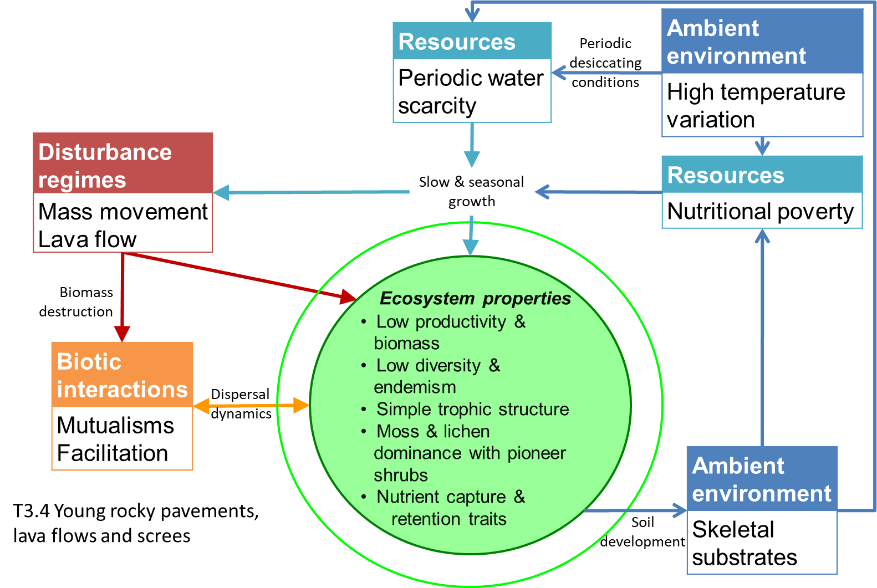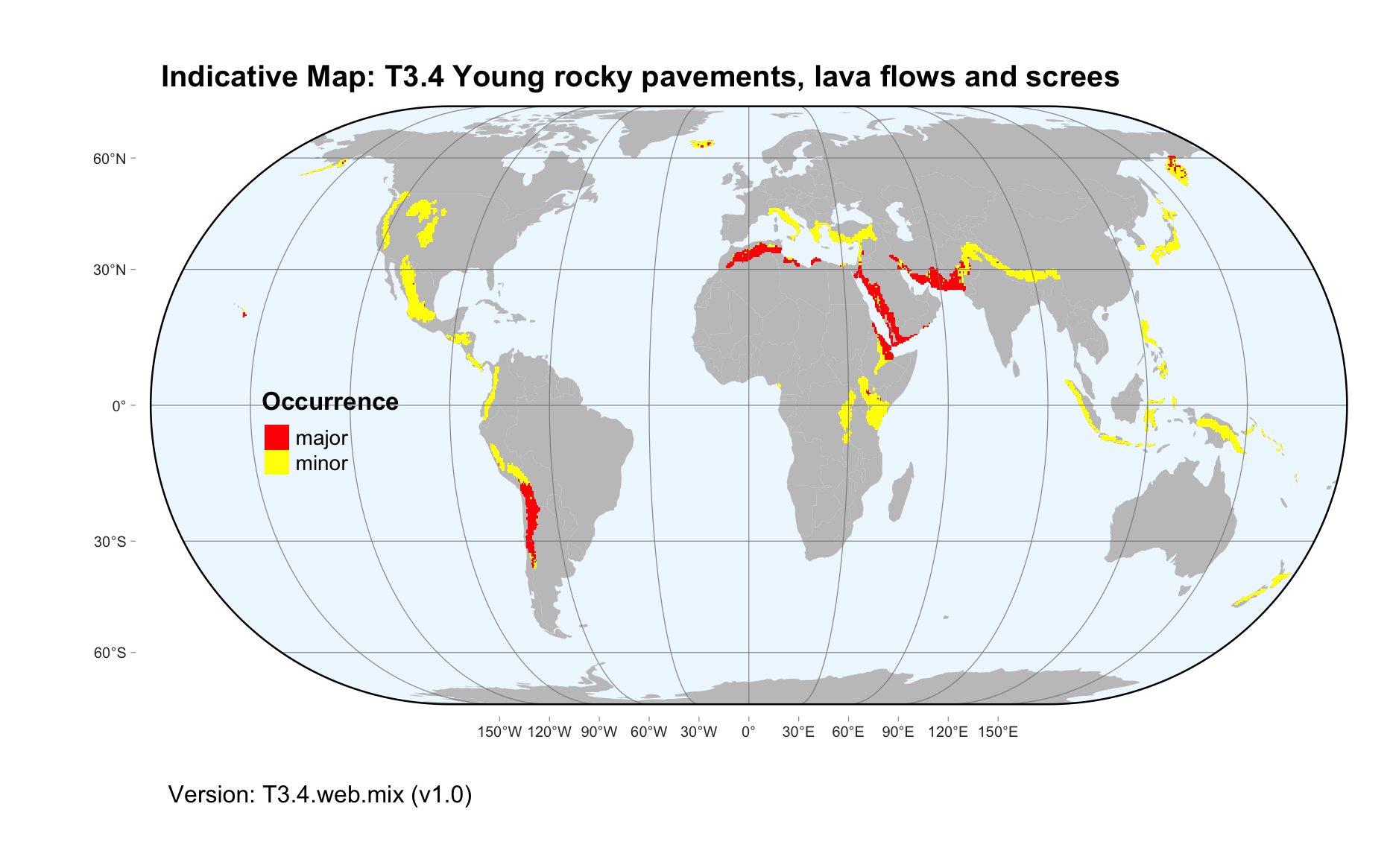Global ecosystem typology
Alternative site for the Global ecosystem typology with additional information for ecosystem profiles and indicative maps.
This site is maintained by jrfep
T3.4 Young rocky pavements, lava flows and screes
Biome: T3. Shrublands and shrubby woodlands biome
Contributors:
(texts)
With a scattered distribution globally, these young rocky ecosystems are exposed to extreme temperatures, weathering and disturbance, and have limited capacity to retain water and nutrients. Analogues in icy environments belong to T6.2. Productivity and diversity are consequently low. Lichens and mosses are often abundant and important to ecosystem development, slowly building soils through incremental retention of moisture and nutrients. Successional development of soils and vegetation may be interrupted by landslides, eruptions and other mass movements. Small-leaved pioneer shrubs and grasses are sparse, often growing in crevices. The simple foodwebs are comprised mainly of microbes and itinerant organisms, with few resident vertebrates other than reptiles and ground-nesting birds.
Key Features
Low-diversity cryptogam-dominated systems with scattered herbs and shrubs on skeletal substrates with limited nutrients and moisture.
Overview of distribution
Around the Pacific Rim, African Rift Valley, Mediterranean and north Atlantic.
Profile versions
- v1.0 (2020-01-20): DA Keith
- v2.0 (2020-06-15): DA Keith; NA Cutler
- v2.01 ():
- v2.1 (2022-04-06): DA Keith; NA Cutler Full profile available at official site
Main references
Selected references for this functional group:
Anderson-Teixeira KJ, Vitousek PM, Brown JH (2007) Amplified temperature dependence in ecosystems developing on the lava flows of Mauna Loa, Hawai’i PNAS 105: 228-233 DOI:pnas.0710214104
Crews TE, Kurina, LM, Vitousek PM (2001) Organic matter and nitrogen accumulation and nitrogen fixation during early ecosystem development in Hawaii Biogeochemistry 52: 259-279 DOI:10.1023/A:1006441726650
Cutler NA, Belyea LR, Dugmore AJ (2008) The spatiotemporal dynamics of a primary succession Journal of Ecology 96: 231-246
Diagrammatic assembly model

Maps
Maps are indicative of global distribution patterns are not intended to represent fine-scale patterns. The maps show areas of the world containing major (coloured red) or minor occurrences (coloured yellow) of each ecosystem functional group. See general notes on maps.
There are 2 alternative versions of the indicative map for this functional group, please compare description and sources below.
T3.4.IM.mix_v1.0
Datasets
- Resolve-Ecoregions-2017
- EarthEnv-LandCover-v1.0
Map references
Dinerstein E, Olson D, Joshi A, Vynne C, Burgess ND, Wikramanayake E, Hahn N, Palminteri S, Hedao P, Noss R, Hansen M, Locke H, Ellis EE, Jones B, Barber CV, Hayes R, Kormos C, Martin V, Crist E, Sechrest W, Price L, Baillie JEM, Weeden D, Suckling K, Davis C, Sizer N, Moore R, Thau D, Birch T, Potapov P, Turubanova S, Tyukavina A, de Souza N, Pintea L, Brito JC, Llewellyn Barnekow Lillesø JP, van Breugel P, Graudal L, Voge M, Al-Shammari KF, Saleem M (2017) An Ecoregion-Based Approach to Protecting Half the Terrestrial Realm, BioScience 67: 534–545. DOI:10.1093/biosci/bix014. Data-set available on-line
Tuanmu, M.-N. and W. Jetz (2014) A global 1-km consensus land-cover product for biodiversity and ecosystem modeling Global Ecology and Biogeography 23(9):1031–1045 DOI:10.1111/geb.12182
T3.4.web.mix_v1.0

Datasets
- EarthEnv-LandCover-v1.0
- Resolve-Ecoregions-2017
Map references
Tuanmu, M.-N. and W. Jetz (2014) A global 1-km consensus land-cover product for biodiversity and ecosystem modeling Global Ecology and Biogeography 23(9):1031–1045 DOI:10.1111/geb.12182
Dinerstein E, Olson D, Joshi A, Vynne C, Burgess ND, Wikramanayake E, Hahn N, Palminteri S, Hedao P, Noss R, Hansen M, Locke H, Ellis EE, Jones B, Barber CV, Hayes R, Kormos C, Martin V, Crist E, Sechrest W, Price L, Baillie JEM, Weeden D, Suckling K, Davis C, Sizer N, Moore R, Thau D, Birch T, Potapov P, Turubanova S, Tyukavina A, de Souza N, Pintea L, Brito JC, Llewellyn Barnekow Lillesø JP, van Breugel P, Graudal L, Voge M, Al-Shammari KF, Saleem M (2017) An Ecoregion-Based Approach to Protecting Half the Terrestrial Realm, BioScience 67: 534–545. DOI:10.1093/biosci/bix014. Data-set available on-line
Check: the Glossary / Profile structure / the public document